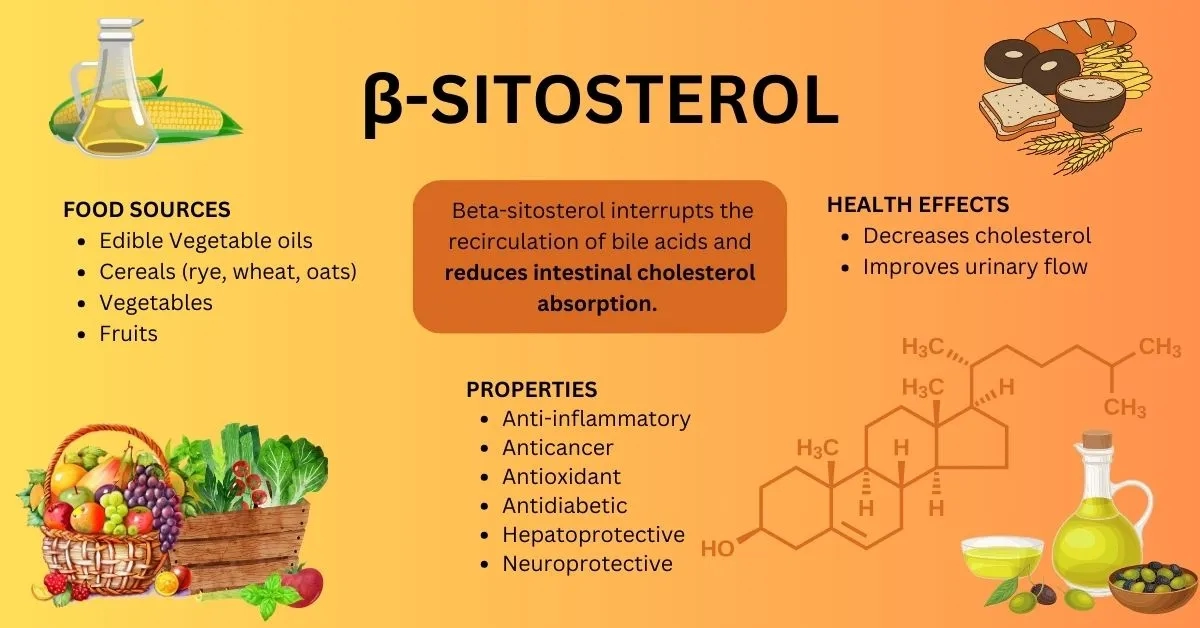Beta Sitosterol — Structure, Food Sources, Benefits, and Supplements
Summary
Beta-sitosterol is a plant sterol with a structure similar to cholesterol. The physicochemical competition between cholesterol and beta-sitosterol leads to the interrupted recirculation of bile acids and reduced intestinal cholesterol absorption.
The main sources of beta-sitosterol are edible vegetable oils and cereals, followed by vegetables, nuts, fruits, and beans.
Food and Drug Administration (FDA) recommends consuming at least 1.3g of plant sterols from foods, including beta-sitosterol, as part of a low-fat diet to reduce blood cholesterol levels and the risk of heart disease.
Daily doses of supplementary beta-sitosterol of less than 1g are ineffective, and beyond 2-3g do not result in additional blood cholesterol reductions. The supplements are generally well-tolerated but may cause mild gastrointestinal adverse effects, such as abdominal pain, indigestion, bloating, nausea, and constipation.
Beta-sitosterol is commonly used to lower blood cholesterol levels and improve the symptoms of benign prostatic hyperplasia (enlarged prostate). Research suggests beta-sitosterol may increase the risk of atherosclerosis; thus, randomized controlled trials are needed before recommending sterol use for its hypolipidemic effects.
Introduction
Beta-sitosterol is a plant-derived nutrient or plant sterol (plant steroid) that is also available as a dietary supplement. It is majorly researched for its effects on blood cholesterol levels and enlarged prostate.
In this article, we’ll discuss the absorption and metabolism, food sources, supplements, recommended doses, and health effects of beta-sitosterol, as well as its relationship with cholesterol.
Classification & Structure
Sitosterol (β-sitosterol or beta-sitosterol) is a type of plant sterol with a structure similar to cholesterol, like campesterol, stigmasterol, and other sterols. Sitosterol is the most abundant dietary sterol, but unlike cholesterol, it is not synthesized in the human body. It doesn’t dissolve in water and converts to oxidized products when heated (1, 2).
The molecular formula of sitosterol is C29H50O. Sitosterol is a stigmast-5-ene with a β-hydroxy group at 3rd position (3).

The structural difference between cholesterol and sitosterol is in the presence of an ethyl group at position 24 of the steroid skeleton (4).
Absorption & Interactions With Cholesterol Metabolism
Animal studies suggest the absorption of beta-sitosterol is higher in females than males. Beta-sitosterol is metabolized into different compounds in the liver and other organs and can be stored in the adrenal glands, brain, skin, ovaries, and testicles.
Beta-sitosterol absorption is 5 times lower than cholesterol absorption. The physicochemical competition between cholesterol and beta-sitosterol leads to the interrupted recirculation of bile acids and reduced intestinal absorption of cholesterol.
About 80% of absorbed beta-sitosterol is excreted via feces and 20% - via skin.
Gut bacteria convert the unabsorbed beta-sitosterol into 24-ethyl-coprostanol, coprostanol, and 24-ethyl-coprostanone (2).
Food Sources of Sitosterol
The main sources of phytosterols, including beta-sitosterol, are edible vegetable oils and cereals, followed by vegetables, nuts, fruits, and beans (5).
The table below shows beta-sitosterol levels in certain foods, calculated per mg/100g (5, 6, 7, 8).
| Vegetable oils | |
| Corn oil | 539.93 ± 160.08 |
| Flaxseed oil | 157.79 ± 24.37 |
| Olive oil | 152.05 ± 58.58 |
| Rapeseed oil | 394.11 ± 146.74 |
| Rice bran oil | 735.17 ± 185.99 |
| Sunflower oil | 170.91 ± 26.18 |
| Cereals | |
| Rye | 23-61 |
| Wheat | 29-49 |
| Rice | 38 |
| Oats | 24-32 |
| Vegetables | |
| Broccoli | 34.5 -35 |
| Cauliflower | 40.8 - 41 |
| Pea | 53.7 - 41 |
| Garlic | 9.8 |
| Soybean | 7.5 |
| Carrot | 14 |
| Cucumber | 3.8 |
| Potato | 1.8 |
| Fruits | |
| Passion fruit | 34 |
| Tangerine | 21 |
| Mango | 19 - 19.4 |
| Orange | 19.6 |
| Cherry | 11 |
| Banana | 9.3 |
Sitosterol Daily Dose & Supplements
Food and Drug Administration (FDA) recommends consuming at least 1.3g of plant sterols from foods, including beta-sitosterol, as part of a low-fat diet to reduce the risk of heart disease (9).
The National Cholesterol Education Program (NCEP) recommends consuming 2g of plant sterols daily to reduce LDL cholesterol levels, with an accepted range of 1-3g (10). Pharmacological studies note that beta-sitosterol supplementation is likely safe to take for 6 months (11).
Daily doses of less than 1g are ineffective, and beyond 2-3g do not result in additional reductions. Plant sterols can be taken 3 times daily or once daily with meals, with any type of meal (12).
As for benign prostatic hyperplasia (BPH), the suggested dose of beta-sitosterol is 60 - 130mg daily in divided doses (13).
Consulting a healthcare provider is suggested before supplementing with plant sterols or beta-sitosterol.
Sitosterol supplements come in 3 forms: capsules, softgels, and tablets. The supplements can also be mixed with other plant sterols, vitamins, or active ingredients.
Side Effects & Contraindications
Beta-sitosterol supplements are generally well-tolerated but may cause mild gastrointestinal adverse effects, such as abdominal pain, indigestion, bloating, nausea, and constipation (11, 14).
Beta-sitosterol-containing supplements are contraindicated for people with previous allergic reactions to beta-sitosterol and those with sitosterolemia.
Drug Interactions
Ezetimibe (Zetia) is a medication used to treat elevated cholesterol and sitosterolemia. Ezetimibe inhibits sterol absorption, decreasing sterol levels in the blood (15).
No major pharmacokinetic interactions have been reported between statins and phytosterols.
Cholestyramine intake from phytosterols should be taken at 2-4 hours intervals to avoid binding in the gut (16).
Health Impact
Beta-sitosterol interferes with cell cycle, programmed cell death (apoptosis), proliferation, survival, angiogenesis (new blood vessel formation), and metastasis. It also has anti-inflammatory, anticancer, antioxidant, antidiabetic, and liver- and heart-protecting effects (17).
Reduced Cholesterol & Cardiovascular Health
Sterols help alleviate high-fat diet-induced blood lipid abnormalities (decrease triglyceride, total, and LDL cholesterol levels in the blood) and fat accumulation in the liver (fatty liver or MASLD) and decrease the risk of heart disease. Beta-sitosterol’s mentioned effects are due to decreased fat absorption and increased fecal excretion of bile acids, as well as its antioxidant and anti-inflammatory properties (18).
The European ESC/EAS guidelines propose using plant sterols, such as beta-sitosterol, to lower blood cholesterol concentrations. Nevertheless, recently published genetic research suggests that they may increase the risk of atherosclerosis and contribute to the severity of atherosclerotic lesions. Accordingly, the German Society of Cardiology (DGK) states the need for randomized controlled trials before recommending the use of plant sterols for their hypolipidemic effects (19, 20).
An early 2000s study on rats found that vegetable oils rich in plant sterols make red blood cells more rigid and reduce their flexibility, shortening their lifespan (20).
Benign Prostatic Hyperplasia
Benign prostatic hyperplasia (BPH) is a non-cancerous enlargement of the prostate gland, which may cause frequent urination, weak stream, and inability or trouble emptying the bladder.
Beta-sitosterol may be effectively used to treat benign prostatic hyperplasia, improving lower urinary tract symptoms (LUTS) and urinary flow rates and scores in men with mild to moderate BPH (21, 22, 23).
Other Health Effects
Beta-sitosterol is commonly used to lower blood cholesterol levels and improve the symptoms of benign prostatic hyperplasia. Research has demonstrated other effects of beta-sitosterol (2, 7, 8, 17, 24, 25):
- Antioxidant, anti-inflammatory, and immune-modulating properties.
- Anti-microbial effects.
- Anti-cancer properties: Beta-sitosterol is considered to have anticancer properties against prostate, breast, colon, stomach, lung, cervix, and larynx cancers, fibrosarcoma, and leukemia.
- Anti-diabetic effects: Beta-sitosterol intake may increase fasting plasma insulin, decrease fasting blood glucose levels, and improve oral glucose tolerance test results.
- Diabetic ulcer wound healing (animal studies)
- Angiogenic effects: Beta-sitosterol promotes blood vessel formation and may play a role in wound healing.
- Anti-arthritic activity: Beta-sitosterol may decrease the activation of inflammatory pathways included in arthritis and inhibit synovial angiogenesis in rheumatoid arthritis, alleviating joint swelling and bone destruction in animal models.
- Neuroprotective properties: Beta-sitosterol may enhance spatial learning in Alzheimer’s patients.
- Reduced anxiety and antidepressant-like effects (animal studies).
Sitosterolemia
Sitosterolemia or phytosterolemia is a rare autosomal recessive disorder of plant sterol, especially sitosterol metabolism. This genetic disorder is characterized by excess accumulation of plant sterols in the blood and tissues due to their hyperabsorption and decreased excretion from the GI tract. Sitosterolemia leads to premature cardiovascular disease, atherosclerosis, and xanthomas and may cause enlargement of the liver and spleen, abdominal pain, and arthralgia.
Sitosterolemia is treated with medications and dietary modifications. A major reduction in sterol intake may significantly reduce serum sterol and cholesterol levels in patients with sitosterolemia (15, 26, 27).
References
- https://www.sciencedirect.com/science/article/abs/pii/S0065242322000488
- https://www.mdpi.com/2305-6320/3/4/29
- https://pubchem.ncbi.nlm.nih.gov/compound/Beta-Sitosterol
- https://link.springer.com/article/10.1134/S106816202005012X
- https://pmc.ncbi.nlm.nih.gov/articles/PMC6723959/
- https://onlinelibrary.wiley.com/doi/full/10.1002/fsn3.4380
- https://www.sciencedirect.com/science/article/abs/pii/B9780128229231000145
- https://www.tandfonline.com/doi/full/10.1080/19476337.2024.2337886
- https://www.accessdata.fda.gov/scripts/cdrh/cfdocs/cfcfr/cfrsearch.cfm?fr=101.83
- https://pmc.ncbi.nlm.nih.gov/articles/PMC2793103/
- https://pmc.ncbi.nlm.nih.gov/articles/PMC7098410/
- https://www.medscape.com/viewarticle/725629_11
- https://reference.medscape.com/drug/bayer-heart-health-advantage-phytosterols-344494
- https://www.sciencedirect.com/science/article/abs/pii/B978143771793800039X
- https://www.ncbi.nlm.nih.gov/books/NBK572142/
- https://www.medscape.com/viewarticle/725629_10
- https://www.sciencedirect.com/science/article/abs/pii/S0009279722003222
- https://pmc.ncbi.nlm.nih.gov/articles/PMC6226309/
- https://link.springer.com/article/10.1007/s13659-024-00451-1
- https://link.springer.com/article/10.1007/s11883-021-00964-x
- https://bmcurol.biomedcentral.com/articles/10.1186/s12894-020-00648-9
- https://www.uptodate.com/contents/medical-treatment-of-benign-prostatic-hyperplasia
- https://www.cochrane.org/CD001043/
- https://www.researchgate.net/publication/354332657
- https://pmc.ncbi.nlm.nih.gov/articles/PMC8918576/
- https://pubs.rsc.org/en/content/articlehtml/2018/ra/c7ra11364a
- https://www.ncbi.nlm.nih.gov/books/NBK395586/
- https://emedicine.medscape.com/article/948892-overview

